Today, we worked on the armrest, the fretboard and the bridge.
First, I should explain that I wanted to make an armrest both for its apparent utility (avoid dampening and increased comfort for the player) but also for the experience of making one while working with Roy. Roy recently made a magnetic armrest for a guitar but I was flip-flopping between a magnetic one or gluing it to the body. Last weekend, I thought I’d glue it, but after re-reading James Lister and Trevor Gore’s comments about magnetic armrests, I finally decided on that approach. This preamble might help explain why last week I glued in the lining and why this week, I started to chisel out slots in the lining for magnets. If I’d decided on a magnetic armrest earlier, I might have cut the lining to accommodate the magnets before gluing it into the body of the guitar. Anyhow, I began the day by cleaning up the bent and 6mm laminated walnut I had prepared on day 14 by planing the edges and trimming the ends. Finally, I rubbed it over a sanding board to ensure there was a nice flat surface to glue the top of the armrest to.
The 250mm walnut side of the armrest had lost a little of its shape since it was bent and glued – not by much and just at one end – so we figured we’d have to pull it back into line when gluing it to the top part. Later, Roy told me that “a curved rest laminated from multiple layers of 1mm veneer (as I did), retained its shape completely, whereas your 3 layers of 2mm walnut moved at the end(s). This is why curved furniture is multi layered. We could have used 1mm thick veneer with a final 0.6 walnut veneer for colour matching, would have given a more perfectly shaped curve without needing the bending iron.”
I’d bought a 4mm sheet of quarter sawn padauk and traced the outline of the body with a sharp pencil. I then cut the outside of it on a bandsaw and finished it with a sanding drum on Roy’s pillar drill.
The inside of the padauk needs cutting to shape too and the walnut will be glued to a 6mm line scribed in from the edge, but that must wait. Next, I wrestled with magnets. I had bought 20 15x3mm N35 rare earth magnets on the advice of Roy who had previously used 12x3mm magnets and felt that stronger ones would be an improvement. My 15mm N35 magnets are rated 30% stronger than 12mm N35 magnets. If you’ve not handled these magnets you’re in for some fun. Given their small size, they are extremely strong and while figuring out how to best employ and situate them in the armrest and in the side of the guitar, the damn things kept flying across the worktop sticking to each other or any other piece of metal. At times it was comical but also painful when they trap the ends of fingers.
Anyway, I took the bent walnut, positioned it where it would eventually sit on the rib and then marked the horizontal distance between each magnet, making sure to avoid the upright struts reinforcing the ribs. Then, taking account of the purfling, the soundboard and the need to have it raised off the soundboard, I marked the vertical position of the magnets, such that they would sit partly embedded in the lining of the guitar. I then drilled 15x3mm holes into the walnut for the magnets to be superglued flush with the surface of the wood. Each 15x3mm magnet weighs 0.48g.
Next – and this is quite important when handling 16 of these powerful magnets all in close proximity of each other – I paired up 8 sets of magnets (note: I only ended up pairing four of them for the finished arm rest) so that they stuck to each other and I numbered the top of each pair so as to identify the order of them and because they are identical back and front, so I could glue them into the guitar the correct way around. The last thing I want is to glue them in and then discover that some pairs are attracting and some are repelling.
I slid the magnets apart (they are too small and strong to prise apart easily) and put the numbered ones well away from the workspace. Next, I took the bent walnut with the embedded magnets and positioned it on the side of the guitar and took a single magnet (number eight) and placed it on the inside of the rib. It grabbed the armrest and allowed me to move the magnet exactly into place along the inside curve of the rib, indicating the position in the lining I needed to cut. There seemed to be no more accurate way of ensuring that each pair of magnets would meet each other in exactly the right place. You can see from the photo below, first where I circled the position of the magnet along the rib and then the corresponding slot that I cut out of the lining for it to drop into. The horizontal pencil line above the magnet was the depth marker that I checked against, chiselling a little out of the lining and dropping the magnet into the slot to see if I’d hit the right depth.
The first slot was a really tedious piece of work, using a 1 and 2mm chisel to carefully remove the wood. The answer is to make plenty of room for the magnet, taking out 4mm for the depth of the magnet which allows easier access for the chisel. The next 7 slots should be easier and faster and I’ll do them over the next week. We tested whether the first slot had been successfully positioned, allowing the two magnets to find each other on the rib and sure enough, the walnut naturally found its place with its top edge raised above the soundboard. You’d think it was magic.
I will repeat this for each magnet, making sure that each is correctly positioned before moving on to the next. Making the armrest has been a lot of fun so far – time consuming but a great problem-solving exercise. Fingers-crossed it will work well. I have a nagging concern that using 8 magnets might make it difficult to actually remove from the guitar, although sliding it up and off should be OK (the final arm rest only uses four paired magnets and does not move at all when in use).
Next, we turned to the fretboard. I stuck masking tape down the two sides to make it easier and more visible to mark out. Then, finding the centre line I had previously marked I used dividers to mark the width at the nut and the 12th fret. I scored a line between each and pulled off the outside piece of tape to reveal the taper I need to achieve. After taking much of it off with the bandsaw, I planed it exactly to the line making sure the edge of the fretboard was square with the face.
Putting the fretboard to one side, we spent the rest of the day working on the bridge(s). I’m wondering whether to use Padauk or Madagascan Rosewood. The binding of the guitar will be Padauk, as is half of the armrest. I had assumed the padauk would have lower mass than the rosewood, but the padauk I have is 822kg/m3 and the rosewood is 819kg/m3 so there seems to be no benefit there. Anyway, I carefully cut both bridge blanks to the desired length and then planed it square. The rosewood had a more glassy feel to it when being planed and smelled great.
As I was doing this, Roy was making a sanding block that was shaped to the dome of the soundboard. I then took a scraper and started to shape one side of the rosewood to the dome. When I was nearly there, I marked the centre of the bridge and the centre of the domed sanding block and then sanded back and forth, keeping both lines aligned. It didn’t take much to get it to the desired shape of the soundboard.
Next, I had to reduce the height of the bridge to 9mm, using Roy’s ‘bridge jig’. The top piece of ply for the jig is 9mm and a piece of veneer taped in the bottom of the ‘window’ is the height of the dome. I marked a line along the length of the wood and planed it to the line, tried it in the jig and shaved a little more off so that a ruler could skim across both the jig and the rosewood. As usual, it was a case of making sure the face was planed level and flat.
I then marked the ‘wings’ of the bridge and the location of the string holes. I only needed six holes as I will use ‘string beads‘, Roy’s current preferred method. Using a 1.5mm drill bit, I carefully drilled the holes, using masking tape on the drill bit to indicate when I’d reached the desired depth.
I then cut and chiseled the wings of the bridge and routed the slots. By the end of the day, the basic shape of the bridge was complete and will take strings. I will clean it up next week.
Except for the arm rest, today corresponded to Roy’s book pp. 276-7; 289-93.
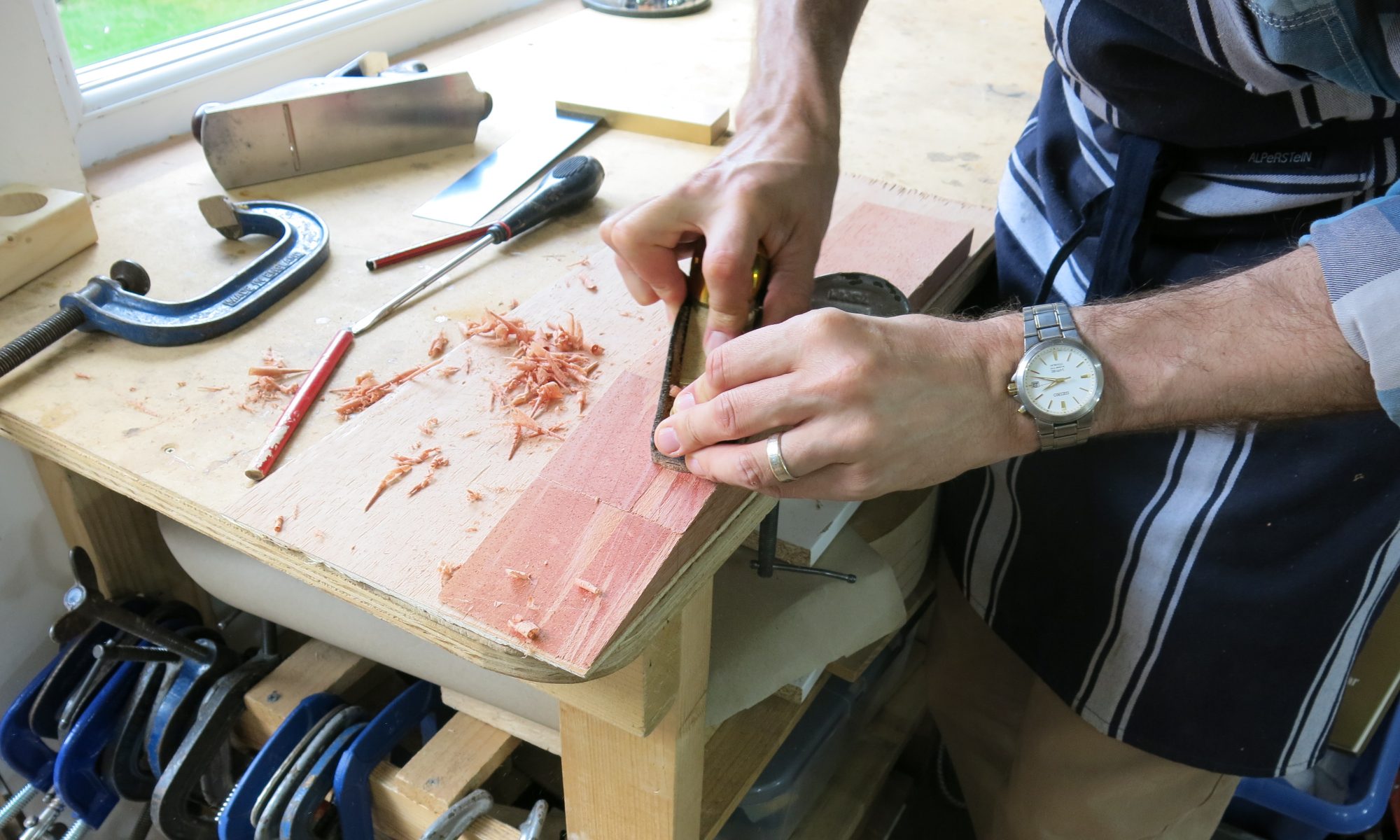
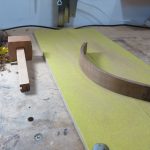
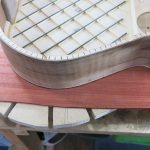
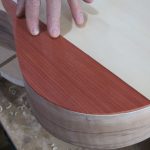
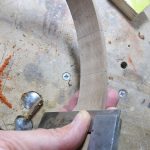

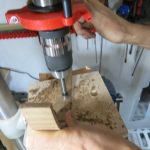
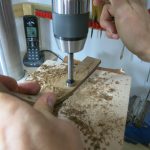
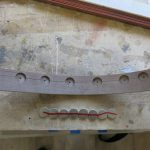
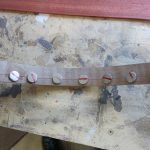
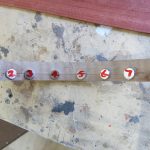

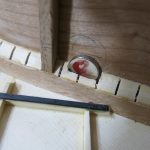
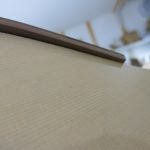
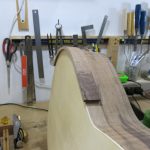
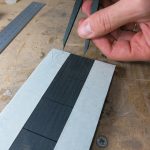

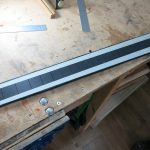
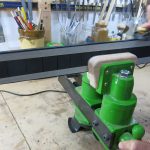

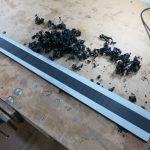
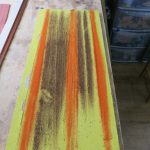
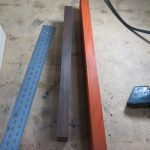
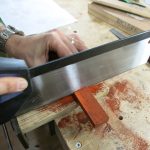
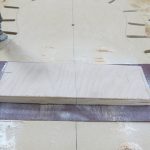
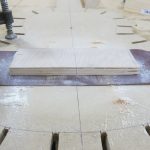
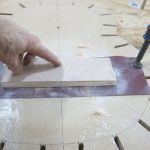
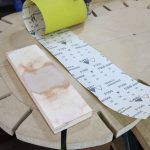

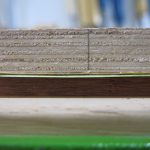
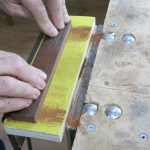

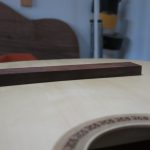
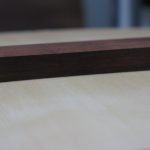
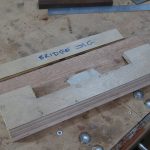

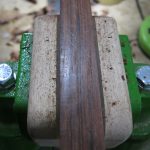
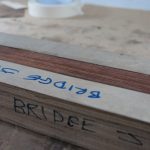
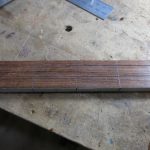
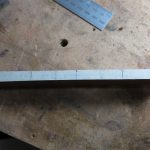
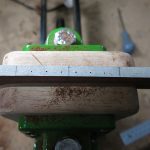
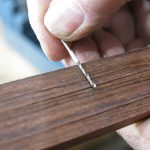
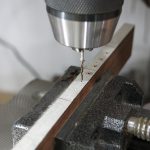
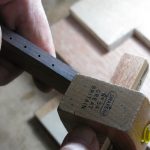
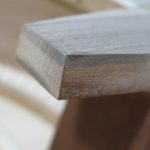
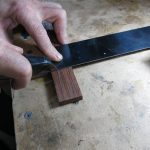
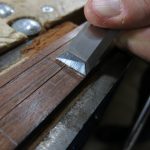
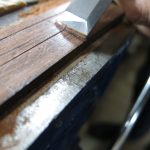
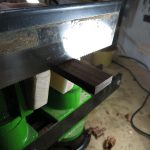

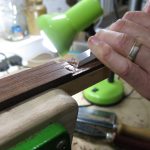
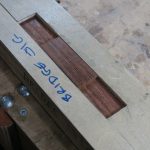
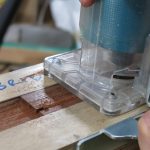

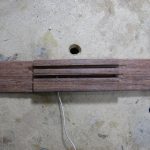
You must be logged in to post a comment.